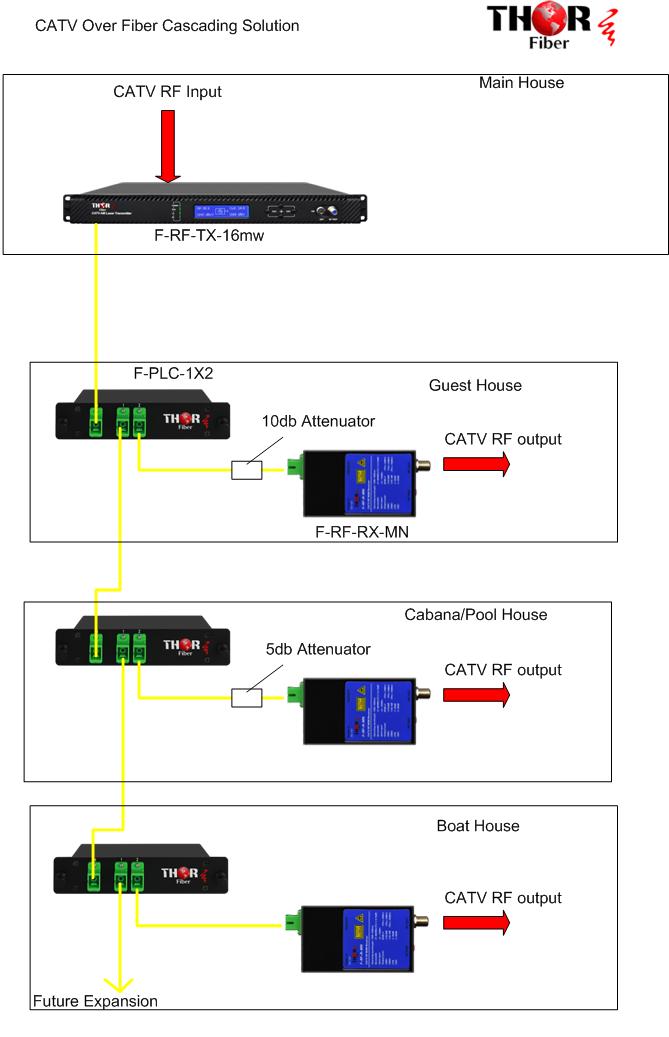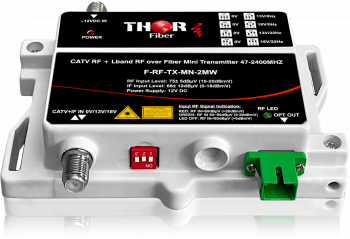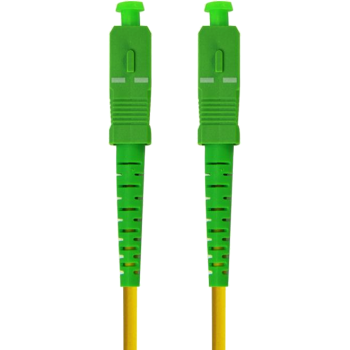This drawing is showing a THOR F-RF-TX-16mw transmitter sending RF (Radio Frequency) signal over single-mode SC/APC (Standard Connector/Angled Polished Connector) fiber optic cables to 3+ locations with a receiver at the end of each fiber optic coupler. The main house will hold the THOR F-RF-TX-16mw transmitter with a satellite or RF set-top box plugged into the RF IN port. The SC/APC fiber connection on the back of the unit will be utilized to run the signal from the Main House to the Guest House. Once in the Guest House, the signal will be plugged into the F-PLC-1x2 fiber coupler so one fiber cable can go the receiver and the other port can be used to transport to the Cabana/Pool House. Each F-PLC-1x2 has a db (Decibel) loss of 4.5db once split so at the first location a 10db Attenuator will be used to cut the 16mw signal down to be interpreted by the F-RF-RX-MN receiver. You'll notice that once at the third location, one only needs a 5db attenuator and at the Boat House there is no attenuation needed. Each F-RF-RX-MN receiver will be plugged into a TV through the RF port in each location.
Unveiling the Wonders of RF over Fiber Technology: Advantages, Disadvantages, and Diverse Applications
Introduction:
RF over Fiber (RFoF) technology stands at the forefront of modern communication solutions, bridging the gap between radio frequency (RF) signals and fiber optic transmission. This innovative technology has gained widespread recognition for its diverse range of applications, offering numerous advantages and some considerations. This article delves into the essence of RF over Fiber, exploring its technology, benefits, drawbacks, and various use cases across different frequencies.
Understanding RF over Fiber Technology:
RF over Fiber is a sophisticated technology that involves the conversion of incoming RF signals into optical signals, allowing for their transmission over long distances through single-mode fiber cables. The process typically includes an optical transmitter converting the RF signal into an optical signal, which is then transmitted over the fiber link and converted back to an RF signal by an optical receiver at the destination.
Advantages of RF over Fiber Technology:
-
Long-Distance Transmission: RF over Fiber excels in transmitting RF signals over longer distances without significant signal degradation, making it ideal for applications that require signals to traverse extensive geographical areas.
-
Immunity to Electromagnetic Interference (EMI): By converting RF signals into optical signals, RFoF technology eliminates susceptibility to EMI, ensuring a stable and interference-free transmission even in challenging electromagnetic environments.
-
High Data Capacity: The technology supports a broad range of frequencies, ranging from FM radio and Wi-Fi to regional sports broadcasts, providing high data capacity suitable for diverse applications.
-
Single Fiber Operation: RF over Fiber can transmit multiple RF signals over a single fiber, optimizing bandwidth utilization and simplifying cable management.
-
Security: Fiber optic cables offer enhanced security as they do not emit detectable electromagnetic signals, reducing the risk of signal interception.
Disadvantages and Considerations:
-
Cost: Implementing RF over Fiber technology may involve initial setup costs, including optical transmitters, receivers, and fiber optic cables. However, the long-term benefits often outweigh these upfront expenses.
-
Complexity: Integrating RF over Fiber modules and managing the technology requires expertise, potentially adding a layer of complexity to system setups.
Diverse Applications of RF over Fiber Technology:
-
Telecommunications: RF over Fiber finds extensive use in telecommunications, facilitating high-speed internet and regional sports broadcasts.
-
Broadcasting: FM radio and television broadcasting benefit from RFoF technology, enabling the efficient transmission of signals over long distances.
-
Military and Aerospace: RF over Fiber is employed in military and aerospace applications, providing reliable signal transmission for critical systems such as inertial navigation.
-
Wi-Fi Connectivity: The technology contributes to Wi-Fi connectivity solutions, ensuring robust and interference-free communication in various environments.
Frequencies and Suitable Applications:
-
FM Radio Frequencies: Ideal for broadcasting FM radio signals over extended distances.
-
Wi-Fi Frequencies: Enables the transmission of Wi-Fi signals for high-speed internet service.
-
Regional Sports Frequencies: Supports the broadcast of regional sports events with high data capacity.
-
Inertial Navigation Frequencies: Applied in military and aerospace applications for reliable signal transmission in inertial navigation systems.
Conclusion:
RF over Fiber technology stands as a testament to the continuous evolution of communication solutions. Its advantages in long-distance transmission, immunity to EMI, and suitability for diverse frequencies make it a valuable asset in various industries. While considerations like cost and complexity exist, the benefits offered by RF over Fiber pave the way for enhanced connectivity and communication in the digital age. As technological advancements persist, RF over Fiber remains a key player in ensuring efficient and reliable signal transmission across different applications and frequencies.

 ES
ES









